The Role of Saffron in Spanish Cuisine and Culture

A Glimpse into Saffron's History in Spain
Saffron, often referred to as 'red gold,' has a rich history in Spain that dates back to ancient times. Originally brought to the Iberian Peninsula by the Moors, this precious spice quickly became a staple in Spanish kitchens. Its distinct color and flavor have made it an integral part of Spanish culture, symbolizing not just culinary richness but also a deep historical connection.
Saffron is the most expensive spice by weight, but the flavor it brings to dishes is priceless.
As Spain's climate proved ideal for saffron cultivation, regions like La Mancha became renowned for producing some of the highest quality saffron in the world. The saffron flower blooms for only a short period each year, making its harvest a labor-intensive process that has been passed down through generations. This tradition reflects the dedication and pride Spanish farmers take in their craft.
Today, saffron is celebrated not only for its culinary uses but also for its cultural significance. It represents the fusion of various historical influences in Spain, showcasing how food can tell the story of a region's heritage and identity.
The Culinary Uses of Saffron in Spanish Dishes
In Spanish cuisine, saffron is perhaps best known for its starring role in paella, the iconic rice dish that hails from Valencia. The addition of saffron gives the rice its signature golden hue and a unique flavor that is both aromatic and slightly sweet. This dish has become synonymous with Spanish culinary identity, often enjoyed during family gatherings and celebrations.

Beyond paella, saffron is also used in a variety of other traditional dishes, such as risottos, soups, and stews. For instance, in the famous dish 'Arroz Caldoso,' saffron infuses the broth with its vibrant color and complex flavor, elevating the dish to a new level. Its versatility allows chefs to experiment and create new interpretations of classic recipes.
Saffron's Rich Cultural Heritage
Saffron symbolizes Spain's culinary history and cultural fusion, reflecting its significance in traditions and celebrations.
The use of saffron isn't limited to savory dishes; it also finds a place in desserts. Spanish sweets like 'Arroz con Leche' (rice pudding) often incorporate saffron to add an exotic twist. This highlights the spice's ability to enhance both savory and sweet flavors, making it a beloved ingredient across the culinary spectrum.
Cultural Significance of Saffron in Spain
Saffron's importance in Spanish culture transcends its culinary uses; it is also steeped in tradition and symbolism. For example, during festivals and religious events, saffron-infused dishes are often served to symbolize prosperity and good fortune. This connection to cultural practices emphasizes how food can play a vital role in community bonding.
Food is our common ground, a universal experience that tells the story of our culture and traditions.
Moreover, saffron is often associated with rituals and celebrations, such as weddings and religious feasts, where dishes adorned with saffron are prepared to honor guests. Its luxurious nature makes it a preferred ingredient for special occasions, reinforcing its status as a symbol of hospitality and generosity.
In literature and art, saffron frequently appears as a motif representing wealth and elegance. Its vibrant color and distinctive aroma have inspired poets and artists alike, showcasing how this spice encapsulates the essence of Spanish culture in various forms of expression.
The Economic Impact of Saffron Cultivation
Saffron cultivation plays a significant economic role in regions like La Mancha, where farmers dedicate their lands to growing this exquisite spice. The labor-intensive nature of saffron harvesting means that it requires a considerable amount of time and effort, but the rewards can be substantial. With proper care and attention, saffron can yield a high market price, contributing to the local economy.
Additionally, the global demand for saffron has opened up opportunities for Spanish farmers to export their products, enhancing their livelihoods. As consumers worldwide increasingly seek authentic and high-quality ingredients, Spanish saffron has gained recognition, allowing producers to thrive in a competitive market.
Economic Importance of Saffron
Saffron cultivation significantly contributes to the local economy while facing challenges related to market demands and environmental factors.
However, the economic success of saffron cultivation comes with challenges, including environmental factors and market fluctuations. Farmers must navigate these issues while continuing the traditions that have sustained saffron production for centuries, striking a balance between heritage and modern demands.
Saffron in Modern Spanish Gastronomy
In contemporary Spanish cuisine, saffron remains a beloved ingredient, embraced by both traditional chefs and modern culinary innovators. Renowned chefs are reinterpreting classic dishes by incorporating saffron in unexpected ways, showcasing its versatility and timeless appeal. This blend of tradition and innovation keeps saffron at the forefront of Spanish gastronomy.
Food festivals and culinary events often highlight saffron, showcasing its importance in both traditional and avant-garde cooking. These gatherings not only celebrate the spice but also educate attendees about its origins, uses, and cultural significance. This growing interest reveals how saffron continues to inspire new generations of chefs and food enthusiasts.
Moreover, the rise of organic and sustainable farming practices has led to an increased focus on the quality of saffron. Consumers are becoming more discerning, seeking out saffron that is ethically sourced and produced. This shift reflects a broader trend towards sustainability in the culinary world, aligning with the values of conscious eaters.
Saffron and Health Benefits
Beyond its culinary allure, saffron is also celebrated for its potential health benefits. Rich in antioxidants, saffron is believed to have anti-inflammatory properties and may contribute to overall well-being. Incorporating saffron into your diet can be a flavorful way to enhance your health, making it a valuable addition to both traditional and modern dishes.
Some studies suggest that saffron may improve mood and alleviate symptoms of depression, earning it a place in the realm of natural remedies. This growing interest in the spice's therapeutic properties has led to increased research and exploration of saffron's potential benefits, particularly in holistic health practices.
Modern Culinary Innovation with Saffron
Today, saffron is embraced by chefs in both traditional and innovative dishes, showcasing its versatility and lasting appeal in Spanish gastronomy.
However, while saffron can offer health advantages, it’s essential to consume it in moderation. Like any ingredient, balance is key, and combining saffron with a varied diet can maximize its benefits. This underscores the importance of understanding the role of ingredients in our diets, both for flavor and health.
Saffron: A Symbol of Spanish Pride
As we explore the multifaceted role of saffron in Spanish cuisine and culture, it becomes evident that this spice is more than just an ingredient; it is a symbol of pride and identity. For many Spaniards, saffron represents a connection to their heritage and a celebration of their culinary history. It serves as a reminder of the rich tapestry of influences that have shaped Spain's culinary landscape.
Saffron festivals and local markets often showcase the dedication of artisans and farmers who work tirelessly to preserve this cultural treasure. Visitors to Spain can experience this pride first-hand by participating in saffron harvests or tasting dishes crafted with locally sourced saffron, fostering a deeper appreciation for this unique ingredient.

Ultimately, saffron embodies the essence of Spanish cuisine—where tradition meets innovation. Its continuing evolution in the culinary world reflects the dynamic nature of Spanish culture, making saffron a cherished ingredient that will undoubtedly remain significant for generations to come.